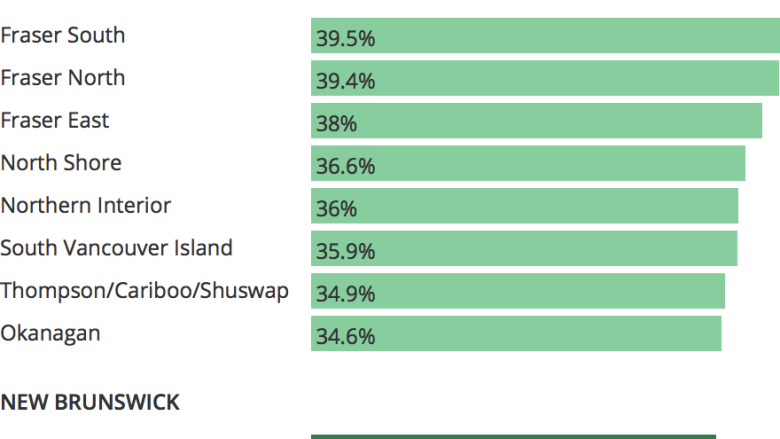B.C. leads the country in C-section deliveries, data reveals
More than one in three deliveries in B.C. hospitals were by C-section last year, the highest rate of surgical birth in Canada, new national data reveals.
B.C.'s overall caesarean rate was 35 per cent, according to figures released Thursday by the Canadian Institute for Health Information (CIHI). This compared with 28 per cent nationally.
Cat Crick's two daughters were both born by C-section at B.C. Women's Hospital in Vancouver, and she's full of advice for other women who find themselves in a similar situation.
"If at all possible, have some help around the house during the first month of recovery. Also be aware of the signs and symptoms of infection and advocate for yourself if you think you might not be healing as you think you should be," the Surrey resident told CBC News in an online conversation.
"And have midwives involved in your care. I can't say enough wonderful things about my midwifery team."
Highest rates in Fraser Health
Eight of the 10 health regions in Canada with the highest overall caesarean rates were in B.C., and the highest rates in the country were in Metro Vancouver's Fraser Health region, at close to 40 per cent.
Tasleem Juma, a spokesperson for Fraser Health, said the health authority is trying to reduce its rate of C-sections and promote vaginal birth. Fraser Health recently hosted a provincial workshop on the subject.
"We work with our patients to ensure they are aware of the options available and the risks associated with each delivery, including working with mothers who have had a C-section to educate them about the potential of having a vaginal birth on their second child," Juma wrote in an email.
The country's lowest C-section rate was in the Northwest Territories, at 19 per cent.
Across Canada, the rate of C-sections increased over the last two years, even as the hospital birth rate declined. Caesareans remained by far the most common type of surgery performed in Canadian hospitals.
The CIHI data did not distinguish between planned and emergency C-sections.
For Crick, neither surgery was a choice.
When her eldest daughter, Sabrina, was getting ready to arrive in 2013, she was in breech instead of the typical head-first position. When attempts to turn her failed, Crick learned that the obstetrician on call was not comfortable attempting a vaginal birth.
"I was a little surprised. I had assumed that all OBs at Women's would be trained or comfortable in vaginal breech deliveries," Crick said.
Little Sabrina arrived just 40 minutes after the crucial decision to undergo surgery, but Crick's recovery took much longer. There were complications with the surgical wound on her belly and it took about two months to heal.
And so it's no surprise that Crick was hoping for a vaginal birth when her youngest, Fiona, arrived last year. Unfortunately, there were complications once again, and Crick ended up under the knife for a second time.
"In both cases, I was able to hold my daughters immediately after they were born, and they breastfed while I was being stitched up. We all went into the recovery room together," she said.
Epidurals less common in B.C.
Meanwhile, the CIHI data shows that women who delivered vaginally in B.C. were significantly less likely to receive an epidural than those in other parts of Canada. Forty per cent of women in B.C. opted for an epidural in 2016-17, compared with 72 per cent in Quebec.
Alberta had the country's highest rate of low-birth weight babies, with seven per cent weighing 5.5 pounds or less. This compared with six per cent in B.C.



